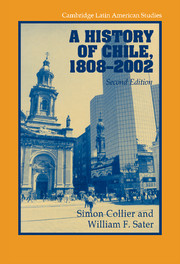Book contents
- Frontmatter
- Contents
- List of maps
- Preface to the Second Edition
- A note on geography
- CAMBRIDGE LATIN AMERICAN STUDIES
- PART I Birth of a nation-state, 1800s–1830s
- PART II The rise of a republic, 1830s–1880s
- PART III The nitrate era, 1880s–1930s
- 7 The Parliamentary period, 1882–1920
- 8 The Lion and the mule, 1920–38
- PART IV Industrial advance and the dawn of mass politics, 1930s–1960s
- PART V Democracy and dictatorship, 1960s–2000s
- Glossary of Spanish terms
- Initials and acronyms
- Further reading
- Index
8 - The Lion and the mule, 1920–38
Published online by Cambridge University Press: 05 June 2012
- Frontmatter
- Contents
- List of maps
- Preface to the Second Edition
- A note on geography
- CAMBRIDGE LATIN AMERICAN STUDIES
- PART I Birth of a nation-state, 1800s–1830s
- PART II The rise of a republic, 1830s–1880s
- PART III The nitrate era, 1880s–1930s
- 7 The Parliamentary period, 1882–1920
- 8 The Lion and the mule, 1920–38
- PART IV Industrial advance and the dawn of mass politics, 1930s–1960s
- PART V Democracy and dictatorship, 1960s–2000s
- Glossary of Spanish terms
- Initials and acronyms
- Further reading
- Index
Summary
I am still the Lion. Ibáñez is the mule.
–Arturo Alessandri (1927)The backwash of the First World War and the 1920s
The end of the First World War ushered in a period of economic and social disturbance in many parts of the world. Chile was no exception. The coming of peace in far-away Europe severely dislocated the Chilean economy, placing additional burdens on a political system which had already demonstrated its inability to deal with less serious dilemmas. These postwar difficulties brought into sharp relief some of the underlying constraints on the economy: overdependence on raw material production, inadequate fiscal and monetary policy, built-in inertia in agriculture. In the end, a combination of economic necessity and political upheaval pushed both the Chilean state and the economy in new directions.
The first and most dramatic effect of the Armistice was to paralyze the salitreras. The Allies' Nitrate of Soda Executive abruptly dumped its once valuable stocks on the open market, driving down prices. The result was entirely predictable: in 1919, exports fell by 66 percent. Although recovering dramatically in 1920, production and exports fell again the following year, this time by half. Over 10,000 miners and members of their families fled to Santiago, infecting the city with despair – and smallpox. The government responded as it had in the past, offering subsidies and buying up the surplus nitrate, while the private producers created the Asociación de Productores de Salitre de Chile which, like the Nitrate Combinations of old, used quotas to stabilize prices.
- Type
- Chapter
- Information
- A History of Chile, 1808–2002 , pp. 202 - 234Publisher: Cambridge University PressPrint publication year: 2004

